
Atlas F1 Magazine Writer
A lot of great champions have been victorious at Monza. No less than six drivers have won the event three times. However, this issue's featured driver isn't one of them. The most remarkable about Niki Lauda's appearances at Monza weren't his two wins or his consecutive poles in 1974 and 1975. It was his race in 1976, just six weeks after escaping death at the Nurburgring.
Despite his good work in qualifying, the weekend turned into a disaster on Sunday. At the start, Lauda dropped far back, leaving just Jackie Stewart, who suffered a clutch failure and didn't complete a single lap, behind. For Lauda, the race held nothing more in it than trying to finish. The Austrian did just that, in the end reaching the chequered flag five laps short of winner Emerson Fittipaldi.
Despite the car being the problem, March's Max Mosley didn't see anything in Lauda, offering him just a Formula Two test seat for the following season. As a result, Lauda opted to drive for BRM in 1973. After flashes of brilliance in Monaco and Canada, Lauda had made his point in Formula One. So by the time the teams arrived in Monza, Lauda had long signed for Ferrari and was just working on finishing the season. Practice was about average for the BRM drivers, with Beltoise leading the threesome in 13th place. Lauda was two places back and Regazzoni, who was following Lauda to Ferrari, made 18th on the grid.
After starting problems for Brabham driver Rolf Stommelen and Surtees's Mike Hailwood, and a good start for the BRM drivers, Beltoise was 12th with Lauda closely behind and Regazzoni in 15th. On lap two, Ferrari driver Arturo Merzario dropped back and thus Lauda was up to 12th. This, however, was shortlived, as Hailwood had found his speed and was clearly faster. A lap later the Briton moved ahead of Lauda. Before the race was ten laps old, Niki Lauda gained a few easy places when Jackie Stewart, Denny Hulme and Mike Beutler dropped far back. Halfway through the race the Austrian even moved to ninth for a short while, when Carlos Pace suffered a blown tyre, but this joy was only temporary. After 33 laps, Lauda suffered the same fate as Pace, ending his race early.
Ferrari of course was a different world altogether. Especially in qualifying, the men from Maranello were nearly impossible to beat and thus it happened that Niki Lauda came to Monza with a stunning five consecutive pole positions in the bag, equalling the record of Stirling Moss and Phil Hill. After qualifying, there was a new record for Lauda, as he successfully fended off the Brabhams, who occupied positions two, three and four, all within half a second of the Austrian.
The following year Ferrari had a rough start, but once the 312T was ready, the team was flying. At the rain-soaked Austrian Grand Prix, three weeks before the Monza race, Lauda had come sixth. This meant that, coming to Monza, the Austrian was half a point short of the Championship, with Carlos Reutemann as his only remaining rival. In qualifying Lauda clearly showed his intentions, claiming pole by little over half a second from his teammate Regazzoni. Fittipaldi was third in the McLaren, over eight tenths behind. Reutemann was nearly KO'd by then, as the Argentine Brabham driver only qualified seventh.
On race day, a good start by Reutemann and a less than perfect one from Lauda brought the two closer together. The Austrian was still ahead, in second, but the Argentine was up to fifth now. A lap later mayhem broke loose as Scheckter and Mass dropped back, while Tony Brise spun and hit Mario Andretti. No problems for the Ferrari drivers who were ahead, Regazzoni leading Lauda. Reutemann managed to overcome the problems too and moved into third. However, it soon became clear that it wasn't Reutemann's day. The Brabham driver had to settle for fourth as Fittipaldi passed him and thus Lauda cruised to his first World Championship, even letting Fittipaldi ahead towards the end of the race.
In 1976, things appeared to go the same way, until that fateful August day in the German Eifel mountains. In a horrific crash at the old Nurburgring, Lauda suffered serious burns to his head and lungs. Only the courage of fellow drivers Brett Lunger, Arturo Merzario and Guy Edwards prevented worse injuries, as they pulled Lauda out of his burning car. For days, Lauda's life was on the line and it seemed obvious that his season was over. However, the Championship was at stake and Lauda was a fighter. To everyone's amazement, the Austrian was back in the car at Monza, just six weeks after being on the brink of death.
The following year started with a big disappointment for Lauda. Ferrari kept him on as a driver, but with the clear mention that Lauda was to be the second driver behind Carlos Reutemann, with whom his relationship was quite bad to put it mildly. Once the circus arrived in Monza, Lauda had beaten his team leader eight to five in qualifying and was leading the Championship comfortably. At Monza, the war within the team took another turn, as Reutemann qualified ahead of Lauda once again. Niki was fifth, while his rival claimed second on the grid, behind World Champion James Hunt.
Reutemann had quite a bad start on Sunday, but he managed to put his car ahead of Lauda, at that point possibly more important than winning or scoring points. No matter what Lauda tried, he couldn't get past the other Ferrari. Racing a race within a race, Lauda finally managed to pull ahead of Reutemann after 35 laps, giving him second in the race behind Mario Andretti who was far ahead. Just a few laps later, Lauda's victory over Reutemann was complete as Carlos spun off on the oil Bruno Giacomelli had left on the track when his engine went the lap before. Andretti, however, was too far away and Lauda settled for second.
With the situation at Ferrari now unworkable, Niki Lauda switched to Bernie Ecclestone's Brabham team. There, the most remarkable moment of the season came at the Swedish Grand Prix, where Gordon Murray's latest innovation was presented: the fan car. The car, helped by a huge fan at the back, won the race and was never seen again after many protests by the competition. After that, the season was basically done as Lotus were simply too far ahead of the competition. At Monza, Lauda achieved the usual second row grid position, qualifying fourth behind Andretti, Villeneuve and Jabouille.
In 1979 Lauda stayed with Brabham, but things were less comfortable than the previous season. The car was not fast enough in qualifying and one of the most unreliable cars ever seen on the grid. Of the 12 races before Monza, Lauda reached the finish only once, in South Africa, where he finished sixth. This led to Lauda going to Monza less than satisfied. Qualifying didn't make Niki much happier. Ninth place was about the maximum that was in the Brabham and that was exactly what Lauda achieved.
To add insult to injury, Lauda's start was terrible, leaving the Austrian 13th after the first lap. Lauda then gave it a final try and ran a superb race, passing car after car to arrive in sixth after 15 laps. Jabouille and Regazzoni ahead were too far away, so Lauda could now concentrate on trying to bring the car home. In the end, the Brabham finally made it to the chequered flag again and with the engines of Laffite and Jabouille blowing in the last part of the race, Lauda was rewarded with fourth place. However, after Friday practice of the next Grand Prix in Canada, Lauda had had enough and retired from Formula One.
In 1982, Lauda made his comeback with McLaren. Ron Dennis convinced the Austrian to return to racing, largely to get Porsche to step into Formula One. In a tragic season which saw the death of Gilles Villeneuve and the end of Didier Pironi's Formula One career, McLaren were more in anticipation of Porsche's arrival than they were really competing. Qualifying at Monza wasn't really top notch, as Lauda put his McLaren in tenth place. In the race, Lauda couldn't do much. He dropped to 12th at the start and wasn't able to overtake anybody. After 21 laps, Lauda stopped when his brakes started to malfunction.
The following year, McLaren and Porsche were a working team and everything went superbly well. Lauda's only competition was his teammate, Alain Prost. In qualifying, the Austrian was usually miles behind Prost and Monza was no exception. Prost was second, just a whisker behind the surprising Nelson Piquet in the Brabham and Lauda was fourth, but no less than two seconds behind the front row. Lauda then suffered back problems, but these were helped out of the way overnight and the Austrian was able to start after all. At the start, he dropped to sixth, but where many drivers retired, Lauda kept his cool. Out of the top ten starters, only Lauda and Patrese reached the finish. Patrese, however, had trouble early on and was far behind. Lauda meanwhile, moved up slowly and after 43 laps he finally took the lead when Tambay retired. In the end, only eight cars reached the finish, with Lauda winning the race almost 25 seconds ahead of Michele Alboreto, who was the only driver on the same lap as the winner.
1985 arrived with Niki Lauda as the World Champion for the third time in his career. The season, however, made it very clear that there was now a new generation of Formula One drivers and that Lauda's days on top of the world were over. The difference between the two McLarens was almost too big considering they were in the same car. Prost had qualified between pole and sixth all the time, finishing ten out of 12 races, while Lauda qualified around tenth most of the time, finishing only three times. However, Lauda came to Monza on a high after taking a race win at Zandvoort, the race before.
The good feeling didn't last too long though, as Lauda put in his second worst qualifying position of the year at Monza. The Austrian was only 16th, just one position better than his Canadian performance. This made him all the more determined to put in a good result and Lauda drove as if the devil in person was chasing him. After dropping to 18th in the first lap, he was 14th after lap two, 13th after lap three, 11th after lap four, 7th after lap eight, 5th after lap 12 and 3rd after 17 laps. From there he started chasing Rosberg and Prost. Sadly, halfway through the race, Lauda's transmission started to fail and a few laps later he was forced to park his car and call it a day. The statistics don't show the true value of this race, but it's absolutely one of Lauda's finest runs at Monza.
When Niki Lauda entered Formula One, he didn't quite burst onto the scene like a Senna or Villeneuve did. With the help of his family money, Lauda bought his way into Formula One as Ronnie Peterson's teammate at March. By the time the circus reached Monza, it had become clear that it had pretty much been a waste of money. The March was slow and unreliable and before the halfway point of the season, the 721X chassis was replaced by the older 721G, which was roughly a Formula Two chassis with a Formula One engine. That didn't help much either, and the total score was one third, two fifths and a sixth place for Peterson.
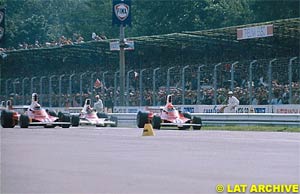 Qualifying for the 1971 Italian Grand Prix showed the usual, with March having to contend with Brabham, Surtees, Tecno and the privateer version of their own cars. In the final session, Lauda pulled out one good lap to sneak ahead of the Surtees of de Adamich and Schenken and qualify 20th.
Qualifying for the 1971 Italian Grand Prix showed the usual, with March having to contend with Brabham, Surtees, Tecno and the privateer version of their own cars. In the final session, Lauda pulled out one good lap to sneak ahead of the Surtees of de Adamich and Schenken and qualify 20th.
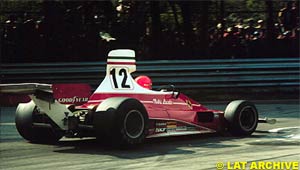 At the start, Lauda grabbed the lead and held on to it. However, it didn't go easy. As the race progressed, Lauda's engine started to get worse and worse and after two thirds of the race was done, the Ferrari driver had to dive into the pits. Sadly for him, this meant the end of the race as the engine was beyond immediate repair. To make things worse, Regazzoni, Lauda's teammate who had take the lead from him, then suffered an engine problem too, handing the win to Ronnie Peterson and Lotus.
At the start, Lauda grabbed the lead and held on to it. However, it didn't go easy. As the race progressed, Lauda's engine started to get worse and worse and after two thirds of the race was done, the Ferrari driver had to dive into the pits. Sadly for him, this meant the end of the race as the engine was beyond immediate repair. To make things worse, Regazzoni, Lauda's teammate who had take the lead from him, then suffered an engine problem too, handing the win to Ronnie Peterson and Lotus.
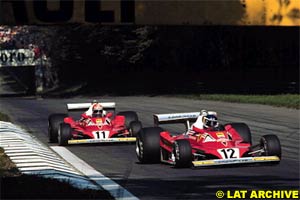 In qualifying, Lauda truly amazed all in the paddock by showing that he was not only back, but that he was fast too. He qualified in fifth, behind Laffite, Scheckter, Pace and Depailler. Niki Lauda, as he admitted later, was in fact very scared in the car and his start showed this. The Austrian dropped back to 12th, after which he was able to settle into the race and gradually move ahead. After 15 laps, the Ferrari driver was back up to sixth place, where he remained for a long time. In the last ten laps of the race, he was then able to pass both Tyrrells of Jody Scheckter and Patrick Depailler to claim an incredible fourth place and keep the title fight alive.
In qualifying, Lauda truly amazed all in the paddock by showing that he was not only back, but that he was fast too. He qualified in fifth, behind Laffite, Scheckter, Pace and Depailler. Niki Lauda, as he admitted later, was in fact very scared in the car and his start showed this. The Austrian dropped back to 12th, after which he was able to settle into the race and gradually move ahead. After 15 laps, the Ferrari driver was back up to sixth place, where he remained for a long time. In the last ten laps of the race, he was then able to pass both Tyrrells of Jody Scheckter and Patrick Depailler to claim an incredible fourth place and keep the title fight alive.
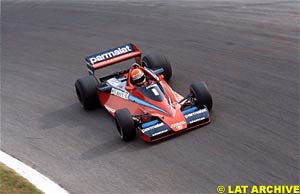 On Sunday things were very grim. In a startline accident, several cars collided. Ronnie Peterson and Vittorio Brambilla were worst off. Peterson was dragged from the flaming remains of his Lotus by James Hunt and Clay Regazzoni, while Brambilla was struck in the head by a flying wheel. The race was red flagged and eventually restarted. Andretti and Villeneuve were off the line fast. Villeneuve led for most of the race, but eventually his tyres got the best of him and Andretti grabbed the lead. However, their battle was of no real importance. Shortly after the race had gotten underway, it was announced that both had jumped the start and would be penalised one minute. Behind the two, Lauda had a comfortable race and stayed close enough to grab the win after the penalties were issued. At last he scored his Monza victory, but it was a joyless one as Ronnie Peterson died the next morning after medical complications.
On Sunday things were very grim. In a startline accident, several cars collided. Ronnie Peterson and Vittorio Brambilla were worst off. Peterson was dragged from the flaming remains of his Lotus by James Hunt and Clay Regazzoni, while Brambilla was struck in the head by a flying wheel. The race was red flagged and eventually restarted. Andretti and Villeneuve were off the line fast. Villeneuve led for most of the race, but eventually his tyres got the best of him and Andretti grabbed the lead. However, their battle was of no real importance. Shortly after the race had gotten underway, it was announced that both had jumped the start and would be penalised one minute. Behind the two, Lauda had a comfortable race and stayed close enough to grab the win after the penalties were issued. At last he scored his Monza victory, but it was a joyless one as Ronnie Peterson died the next morning after medical complications.
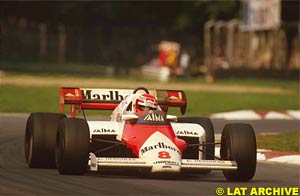 Throughout 1983, McLaren was still waiting for the Porsche turbo engines and at the Dutch Grand Prix, two weeks before Monza, they finally arrived. Of course there was much work to be done and the performance wasn't superb from the start. However, at Monza the McLaren was already a good step ahead in qualifying. After only qualifying 19th at Zandvoort, Lauda now managed to put the car in 13th. The first laps of the race were quite chaotic with many passes back and forth. Lauda kept his starting position into the first corner and battled with Keke Rosberg in the early laps. However, after two laps he had to make a pitstop and was forced to race at the back of the field until the electrics dropped him out of the race after just 24 laps.
Throughout 1983, McLaren was still waiting for the Porsche turbo engines and at the Dutch Grand Prix, two weeks before Monza, they finally arrived. Of course there was much work to be done and the performance wasn't superb from the start. However, at Monza the McLaren was already a good step ahead in qualifying. After only qualifying 19th at Zandvoort, Lauda now managed to put the car in 13th. The first laps of the race were quite chaotic with many passes back and forth. Lauda kept his starting position into the first corner and battled with Keke Rosberg in the early laps. However, after two laps he had to make a pitstop and was forced to race at the back of the field until the electrics dropped him out of the race after just 24 laps.
Please Contact Us for permission to republish this or any other material from Atlas F1.
|
Volume 7, Issue 37
Italian GP Preview
The Italian GP Preview
Technical Preview: Monza
Focus: Lauda in Italy
Columns
Elsewhere in Racing
The Debut Trivia Quiz
Bookworm Critique
The Weekly Grapevine
> Homepage |